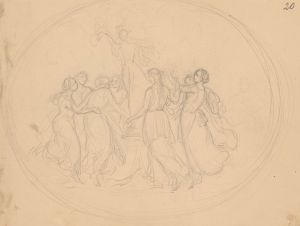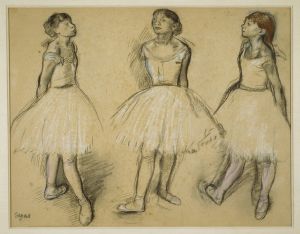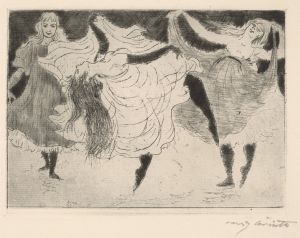
Dancers
A hand-painted replica of Edgar Degas’s masterpiece Dancers, meticulously crafted by professional artists to capture the true essence of the original. Each piece is created with museum-quality canvas and rare mineral pigments, carefully painted by experienced artists with delicate brushstrokes and rich, layered colors to perfectly recreate the texture of the original artwork. Unlike machine-printed reproductions, this hand-painted version brings the painting to life, infused with the artist’s emotions and skill in every stroke. Whether for personal collection or home decoration, it instantly elevates the artistic atmosphere of any space.
Edgar Degas, a prominent French artist associated with the Impressionist movement, is renowned for his captivating depictions of dancers. One of his notable works, "Dancers," exemplifies his fascination with the world of ballet and his innovative approach to capturing movement and the human form. Degas's interest in dancers was not merely aesthetic; it was also a study of the human body in motion, a theme that he explored extensively throughout his career.
"Dancers" is a pastel on paper, a medium Degas favored for its ability to convey the delicate textures and vibrant colors of the ballet. This piece, like many of his works, reflects his keen observation and deep understanding of the ballet world. Degas often frequented the Paris Opéra, where he had access to rehearsals and backstage areas, allowing him to observe dancers in their natural environment. This access provided him with the opportunity to capture candid moments that were not typically seen by the public.
The composition of "Dancers" is dynamic, showcasing Degas's skill in portraying movement. He often depicted dancers in informal poses, either stretching, adjusting their costumes, or caught in mid-motion. This approach was a departure from the more formal and static representations of dancers that were common in art at the time. Degas's dancers are often shown in rehearsal, emphasizing the hard work and discipline that underpin the grace and beauty of ballet.
Degas's technique in "Dancers" is characterized by his use of bold lines and vibrant colors. He employed a layering technique with pastels, building up rich textures that give the work a sense of depth and vitality. His use of light and shadow adds to the realism of the scene, highlighting the contours of the dancers' bodies and the folds of their costumes. This attention to detail and texture is a hallmark of Degas's style, setting his work apart from his contemporaries.
The influence of Japanese prints is evident in Degas's work, including "Dancers." The asymmetrical compositions and the use of empty space in his paintings reflect the impact of Japonisme, a trend that swept through European art in the late 19th century. This influence can be seen in the way Degas frames his subjects, often cropping them in unexpected ways that suggest movement beyond the confines of the canvas.
"Dancers" is not just a depiction of ballet; it is a testament to Degas's innovative spirit and his ability to capture the ephemeral nature of movement. His work offers a glimpse into the world of ballet, revealing both the elegance and the rigor of the art form. Degas's dancers are celebrated for their realism and vitality, qualities that continue to captivate audiences today.
Through "Dancers," Degas has left an indelible mark on the art world, influencing generations of artists who followed. His ability to blend traditional techniques with modern sensibilities has ensured that his work remains relevant and admired. "Dancers" stands as a testament to Degas's mastery of his craft and his enduring fascination with the beauty of movement.


















